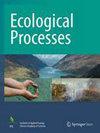The effects of multiple environmental factors on global carbon allocation
IF 3.9
2区 环境科学与生态学
Q1 ECOLOGY
引用次数: 0
Abstract
The allocation of photosynthate among the parts of plants (e.g., leaves, wood tissues and roots) strongly regulates their growth, and this conditions the terrestrial carbon cycle. Recent studies have shown that atmospheric CO2 and climate change dominate the changes in carbon allocation in plants, but the magnitude and mechanism of its effects remain unclear. The Community Atmosphere Biosphere Land Exchange (CABLE) model can accurately simulate the responses of carbon allocation to environmental changes. This study quantifies the contributions of four environmental factors—atmospheric CO2, temperature, precipitation, and radiation—on resource availability and carbon allocation from 1979 to 2014 by using the CABLE model. The results of the CABLE model showed that rising CO2 significantly reduced carbon allocation to the leaves of plants at a global scale, but the other three environmental factors exhibited contrasting effects that dominated the rise in carbon allocation to the leaves. The increased precipitation and CO2 significantly reduced the light availability and increased carbon allocation to the wooden parts of plants. By contrast, the rising temperature reduced the water availability, resulting in a decrease in carbon allocation to the wooden parts. All four environmental factors consistently exhibited negative effects on carbon allocation to the roots, with rising precipitation causing the largest reduction in carbon allocation to them. Moreover, except for CO2, the effects of the other three environmental factors were heterogeneous owing to their variable interactions in different regions. The CABLE model can accurately represent the mechanisms of response of resource availability and carbon allocation to environmental changes. Our study highlights the substantial environmental regulation of global carbon allocation. The responses of carbon allocation to global environmental changes need to be extensively studied through ecosystem models based on different hypotheses.多重环境因素对全球碳分配的影响
光合产物在植物各部分(如叶片、木质组织和根系)之间的分配在很大程度上影响着植物的生长,并制约着陆地碳循环。最近的研究表明,大气中的二氧化碳和气候变化主导着植物碳分配的变化,但其影响的程度和机制仍不清楚。群落大气生物圈土地交换(CABLE)模型可以准确模拟碳分配对环境变化的响应。本研究利用CABLE模型量化了1979年至2014年大气二氧化碳、温度、降水和辐射四个环境因子对资源可用性和碳分配的贡献。CABLE 模型的结果表明,在全球范围内,二氧化碳的增加显著减少了植物叶片的碳分配,但其他三个环境因素则表现出截然不同的影响,它们主导了叶片碳分配的增加。降水量和二氧化碳的增加大大减少了植物木质部的光照,增加了木质部的碳分配。相比之下,温度升高降低了水分供应,导致木质部碳分配减少。所有四种环境因素都对根部的碳分配产生了负面影响,其中降水量增加导致根部碳分配减少最多。此外,除二氧化碳外,其他三个环境因子在不同地区的相互作用也各不相同。CABLE模型可以准确地反映资源可用性和碳分配对环境变化的响应机制。我们的研究强调了环境对全球碳分配的实质性调控。碳分配对全球环境变化的响应需要通过基于不同假设的生态系统模型进行广泛研究。
本文章由计算机程序翻译,如有差异,请以英文原文为准。
求助全文
约1分钟内获得全文
求助全文
来源期刊

Ecological Processes
Environmental Science-Ecological Modeling
CiteScore
8.50
自引率
4.20%
发文量
64
审稿时长
13 weeks
期刊介绍:
Ecological Processes is an international, peer-reviewed, open access journal devoted to quality publications in ecological studies with a focus on the underlying processes responsible for the dynamics and functions of ecological systems at multiple spatial and temporal scales. The journal welcomes manuscripts on techniques, approaches, concepts, models, reviews, syntheses, short communications and applied research for advancing our knowledge and capability toward sustainability of ecosystems and the environment. Integrations of ecological and socio-economic processes are strongly encouraged.
 求助内容:
求助内容: 应助结果提醒方式:
应助结果提醒方式:


